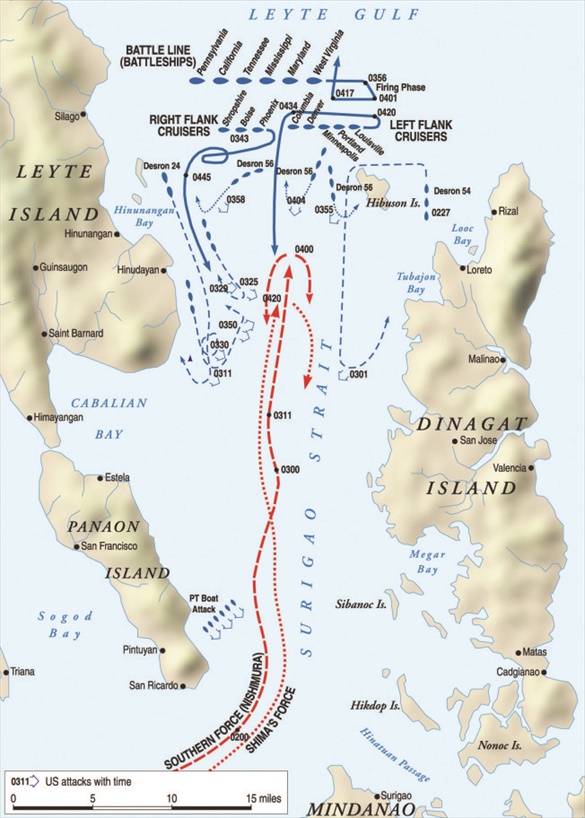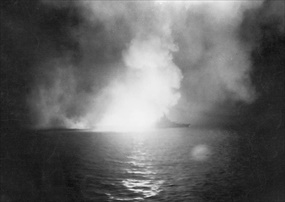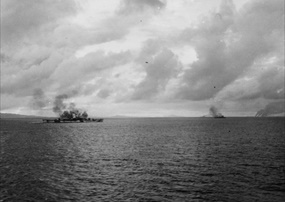BATTLE OF SURIGAO STRAIT CLEAR U.S. VICTORY
Surigao Strait, Philippines • October 25, 1944
In the lightless hours on this date, October 25, 1945, 2 elderly Japanese battleships—Fuso and Yamashiro—escorted by heavy cruiser Mogami and 4 destroyers, steamed into what would become one of the most lop-sided battles in naval history. The warships made up half the Imperial Japanese Navy’s southern strike force under veteran Vice Adm. Shōji Nishimura. Their mission: penetrate Leyte Gulf via the Surigao Strait and assist Vice Adm. Takeo Kurita’s First Diversion Attack Force (“Center Force”) in destroying the U.S. surface fleet and Gen. Douglas MacArthur’s recently established beachhead on the Central Philippine island of Leyte. Flanking the narrow Surigao Strait were Leyte and Dinagat islands to the west and east (see map below). The U.S. Navy would lump the ensuring Battle of Surigao Strait under the titanic Battle of Leyte Gulf (October 23–26, 1944) by virtue of 3 Japanese strike forces, all of them separated by great distances, being part of the IJN’s Shō–Go Plan. Devised in late July 1944, the Shō–Go Plan (shō means “to conquer”) was the last attempt by the Imperial fleet to defend its empire during the Pacific War.
Nishimura’s flotilla left Borneo on October 22, 1944, and entered the south end of Surigao Strait in the early hours of October 25. In a nighttime engagement with warships of the U.S. Seventh Fleet and the Royal Australian Navy, Nishimura’s “Southern Force” (aka “C” Force) was annihilated. American destroyers torpedoed both battleships, the Fuso sinking 40 minutes after being hit, although one source claims it was the Yamashiro that sank first. In any case, the lost battleships represented 50 percent of Nishimura’s battleship strength. Also lost were 3 destroyers, Asagumo, Michishio, and Yamagumo. Despite this, Nishimura pressed on with 1 battleship, 1 heavy cruiser, and his remaining destroyer Shigure—hardly an awe-inspiring force. Because at the northern end of the strait, arrayed bow to stern horizontally, were 6 U.S. battleships carrying between them 48 14‑in/356‑mm and 16 16‑in/406mm guns—the USS California, Maryland, Mississippi, Pennsylvania, Tennessee, and West Virginia. Excepting the USS Mississippi, each of veteran Rear Adm. Jesse Oldendorf’s battlewagons had been damaged during Japan’s December 7, 1941, attack on Pearl Harbor, Hawaii, and returned to service.
Oldendorf planned his defense of the Surigao Strait with skill and overwhelming firepower. Besides 6 battleships (3 with advanced gunnery radar), Oldendorf commanded 8 cruisers, 28 destroyers, and 39 torpedo (PT) boats. Just before the strait met the mouth of Leyte Gulf, Oldendorf’s battlewagons and cruisers stood ready to deliver full broadsides by “crossing the T” on Nishimura’s tattered formation. Already U.S. and Australian destroyers and PT boats on the flanks of the U.S. battle lines had drawn blood by sinking 3 of Nishimura’s destroyers. As all hell lit up the pitch-black sky the results were catastrophic for the Japanese intruders. Nishimura went down with Yamashiro (Fuso?). Mogami and Shiranui beat a wounded retreat. Vice Adm. Kiyohide Shima’s Second Striking Force of 2 heavy cruisers and 4 destroyers, the weaker half of Nishimura’s armada, entered the strait 35 nautical miles/65 km astern of Nishimura. Shima’s flagship Nachi and Mogami collided in the chaos. Having no desire to share the fate inflicted on Nishimura’s fleet, Shima fled the scene only to lose his warships in later engagements around Leyte. The action in the Surigao Strait was the last battleship-versus-battleship action in World War II and one of the few naval battles of the Pacific War in which aircraft played an insignificant role.
Japanese Navy’s Debacle: Battle of Surigao Strait, October 25, 1944
 |
Above: During the one-day Battle of Surigao Strait (October 25, 1944), U.S. Rear Adm. Jesse Oldendorf executed the classic naval maneuver of crossing his enemy’s “T.” The American battle line was able to fire full broadsides at 2 Japanese strike forces that attempted to pass through the straits and merge into Leyte Gulf. They were Vice Adm. Shōji Nishimura’s Southern Force and Vice Adm. Kiyohide Shima’s Second Striking Force, the latter attached to Nishimura’s. Because the strait was narrow, the Japanese naval phalanxes could only reply to the Allies’ salvos initially with forward guns. Nishimura’s warships, first on the scene, were annihilated with the exception of 1 destroyer; Shima’s warships wisely turned tail and fled the battlefield, though not unscathed. The Battle of Surigao Strait was the last battleship-versus-battleship action of World War II. It one of 4 naval actions collectively known as the Battle of Leyte Gulf (October 23–26, 1944) by virtue of their all being caused by the IJN’s Shō–Go Plan. Besides the Battle of Surigao Strait, the others were the Battle of the Sibuyan Sea (October 24), the Battle off Samar (October 25), and the Battle of Cape Engano (October 25–26). The Battle of Leyte Gulf spanned more than 100,000 square miles/258,999 square kilometer, involved hundreds of ships, included nearly 200,000 participants, resulted in the deaths of thousands of seamen from both sides, and was the largest and, to date, last major naval engagement ever fought. Map source: Warfare History Network, October 2016.
 |  |
Left: At 03:16, USS West Virginia’s radar picked up ships of Nishimura’s force at a range of 42,000 yards/24 miles/38 kilometer). West Virginia tracked them as they approached in the pitch-black night. At 03:53, she fired the 8 16‑in/406‑mm guns of her main battery at a range of 22,800 yards/13 miles/21 kilometer), striking the battleship Yamashiro with her first salvo. She went on to fire a total of 93 shells. At 03:55, USS California and Tennessee joined in, firing 63 and 69 shells, respectively, from their 14‑in/356‑mm guns. Radar fire control allowed these American battleships to hit targets from a distance at which the Japanese battleships with their inferior fire control systems could not return fire.
![]()
Right: This photo shows light cruiser USS Denver (foreground) purportedly assisting in shelling Japanese destroyer Asagumo, burning in the background, October 25, 1944. She was one of four destroyers in Nishimura’s “Southern Force.” The others were Michishio, Yamagumo, and Shigure. (Damaged by a direct shell hit and near misses, Shigure was the only one of Nishimura’s warships to survive the Battle of Surigao Strait.) Forced to retire during the sea battle, Asagumo was torpedoed by destroyer USS McDermut and subsequently finished off by gunfire from U.S. Navy cruisers and destroyers with a loss of 191 crewmembers.
Recollection of Naval Lieutenant at Battle of Surigao Strait, October 25, 1944
![]()

 History buffs, there is good news! The Daily Chronicles of World War II is now available as an ebook for $4.99 on Amazon.com. Containing a year’s worth of dated entries from this website, the ebook brings the story of this tumultuous era to life in a compelling, authoritative, and succinct manner. Featuring inventive navigation aids, the ebook enables readers to instantly move forward or backward by month and date to different dated entries. Simple and elegant! Click
History buffs, there is good news! The Daily Chronicles of World War II is now available as an ebook for $4.99 on Amazon.com. Containing a year’s worth of dated entries from this website, the ebook brings the story of this tumultuous era to life in a compelling, authoritative, and succinct manner. Featuring inventive navigation aids, the ebook enables readers to instantly move forward or backward by month and date to different dated entries. Simple and elegant! Click 











